Configure Telemetry settings on Windows 10 devices
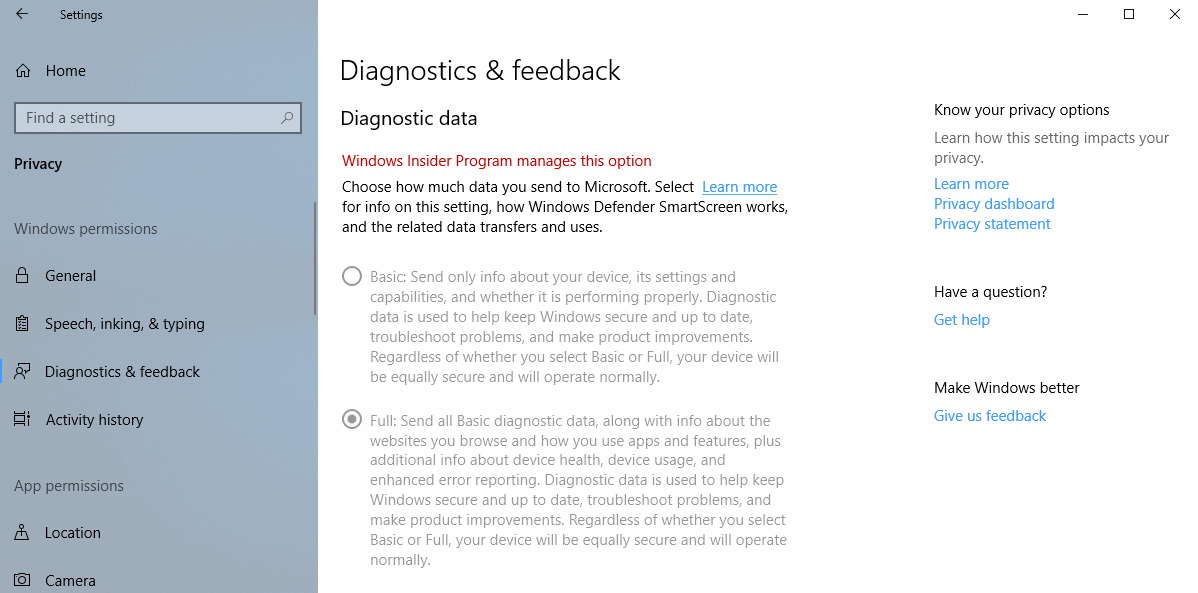
Windows 10 was not Microsoft's first operating system that collected Telemetry data but Microsoft changed what is collected and the control users have over the functionality significantly in Windows 10.
The move to Windows as a Service played a major role in the decision as Microsoft's decision to switch from a "one major new version of Windows every three years" to "two not so big but still significant updates per year" release scheme.
Telemetry, or how Microsoft likes to call it these days, diagnostic data, is important to Microsoft because the company uses diagnostic data in the decision making process.
All editions of Windows 10, with the exception of selected Enterprise editions, collect Telemetry by default. In fact, most versions of Windows 10 come without options to disable the collecting of diagnostic data.
While it is possible to limit the collecting of data to what Microsoft calls a basic level, it is not possible to block the collecting using the preferences of the operating system.
Windows 10 Telemetry settings
Windows 10 supports four different Telemetry settings. Only two of those, Full and Basic, are visible in the Settings application. The two remaining diagnostic levels are Security and Enhanced, and they can only be set using the Group Policy or Registry.
Here is the order based on how much data is collected: Full > Enhanced > Basic > Security
Note: I'm not 100% sure that Enhanced is used for anything as it is not displayed during setup or in the Settings app as an option. It is likely that Microsoft will remove Enhanced eventually.
The Settings app
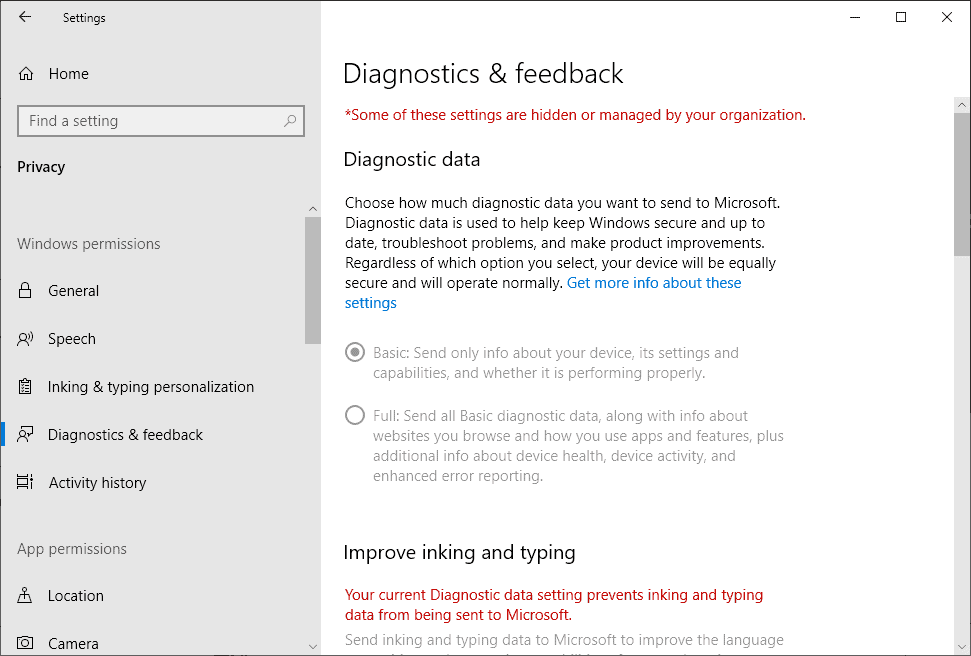
The Settings application gives you the same control over privacy that you get during initial setup of the operating system.
- Use the keyboard shortcut Windows-I to open the Settings app.
- Go to Privacy > Diagnostics & Feedback.
The default Telemetry level is Full. Windows 10 collects a lot of data at this level and transfers the data to Microsoft regularly.
You can switch the diagnostic data level to basic using the Settings app to limit data collecting. Basic is the lowest level available for all consumer versions of Windows 10.
The only exception to the rule is if the device is linked to the Windows Insider Program. Insider Program devices are set to Full data collecting and this is one of the requirements of participating in the program.
Tip: Microsoft revealed what data Windows 10 collects at what level in mid-2017. The first feature update of Windows 10 in 2018 introduces options to view the collected Windows 10 data on the device, and to delete collected data.
The Group Policy
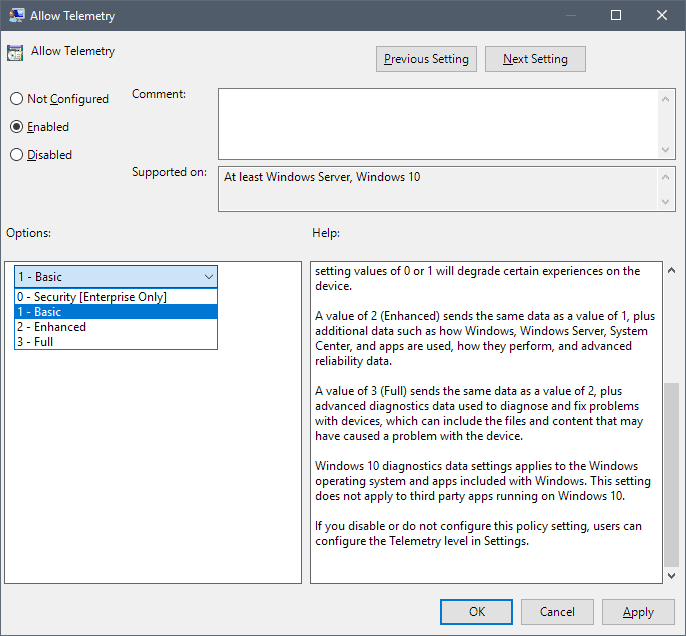
The Group Policy Editor lists all four available Telemetry levels but only three of them are available on consumer devices.
Do the following to open the Group Policy Editor. (Note: not available on Windows 10 Home devices).
- Tap on the Windows-key to open the Start Menu.
- Type gpedit.msc and hit the Enter-key.
Navigate to the following key using the folder structure on the left: Computer Configuration > Administrative Templates > Windows Components > Data Collection and Preview Builds.
Double-click on the Allow Telemetry policy to display it.
The policy is not configured by default which means that the value set during setup or in the Settings app is used. Disabled has the same effect, it does not disable Telemetry collecting completely on the device.
Consumers and small businesses may set Telemetry to Basic, Enhanced or Full only. While it is possible to select Security, that is not advised because the setting is switched internally to Basic automatically, and because it may interfere with update delivery on the system.
The Telemetry levels
The following values are available:
Security
A value of 0 (Security) will send minimal data to Microsoft to keep Windows secure. Windows security components such as Malicious Software Removal Tool (MSRT) and Windows Defender may send data to Microsoft at this level if they are enabled.
Basic
A value of 1 (Basic) sends the same data as a value of 0, plus a very limited amount of diagnostic data such as basic device info, quality-related data, and app compatibility info. Note that setting values of 0 or 1 will degrade certain experiences on the device.
Enhanced
A value of 2 (Enhanced) sends the same data as a value of 1, plus additional data such as how Windows, Windows Server, System Center, and apps are used, how they perform, and advanced reliability data.
Full
A value of 3 (Full) sends the same data as a value of 2, plus advanced diagnostics data used to diagnose and fix problems with devices, which can include the files and content that may have caused a problem with the device.
Setting Telemetry in the Windows Registry
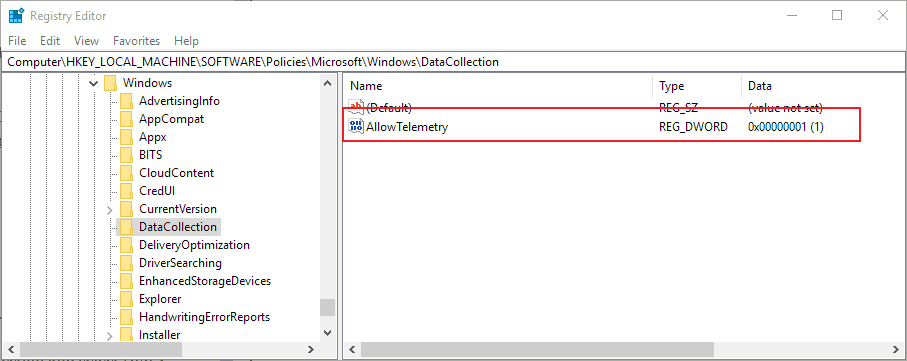
You may set the diagnostic data level in the Windows Registry. The method has the same effect as setting the Telemetry level using the Group Policy.
- Tap on the Windows-key to display the Start Menu.
- Type regedit.exe and hit the Enter-key on the keyboard to start the Registry Editor.
- Confirm the UAC prompt.
To configure Telemetry, go to Computer\HKEY_LOCAL_MACHINE\SOFTWARE\Policies\Microsoft\Windows\DataCollection and change the value of the Dword AllowTelemetry to one of the supported values:
- 0 -- Security (Enterprise only)
- 1 -- Basic Telemetry
- 2 -- Enhanced Telemetry
- 3 -- Full Telemetry
Notes:
If DataCollection does not exist, right-click on Windows and select New > Key to create it.
If the Dword value AllowTelemetry does not exist, right-click on DataCollection and select New > Dword (32-bit Value) to create it.
Telemetry FAQ
Here is a quick list of common questions and answers:
What is Telemetry in Windows 10?
Telemetry, or diagnostic data, is data that Windows 10 collects automatically to send it to Microsoft servers. Microsoft states that the data is anonymized and helps the company develop Windows 10.
How do I turn off Windows 10 data collecting?
The short answer: you can't using built-in functionality. What you can do is change the level of Telemetry from Full to Basic to limit what data is collected and transferred to Microsoft.
Is there really no way?
There is a way, but it may limit other functionality if you are not careful. You need to block Microsoft servers so that connections to these servers is blocked. Check out a script like Debloat Windows 10 which does that but create a backup of the system first.
What's the difference between Telemetry and other Windows 10 privacy settings?
Telemetry refers to the automatic collection of diagnostic data. The remaining Privacy settings control what apps may do for the most part. These settings are not considered Telemetry but they are still privacy related.
Resources
Check out the following Resources if you want to know more about Telemetry and diagnostic data in Windows 10:
- Configure Windows diagnostic data in your organization
- Diagnostic Data Viewer Overview
- Windows 10, version 1709 basic level Windows diagnostic events and fields
- Windows 10, version 1709 enhanced diagnostic data events and fields used by Windows Analytics
- Windows 10, version 1709 diagnostic data for the Full level








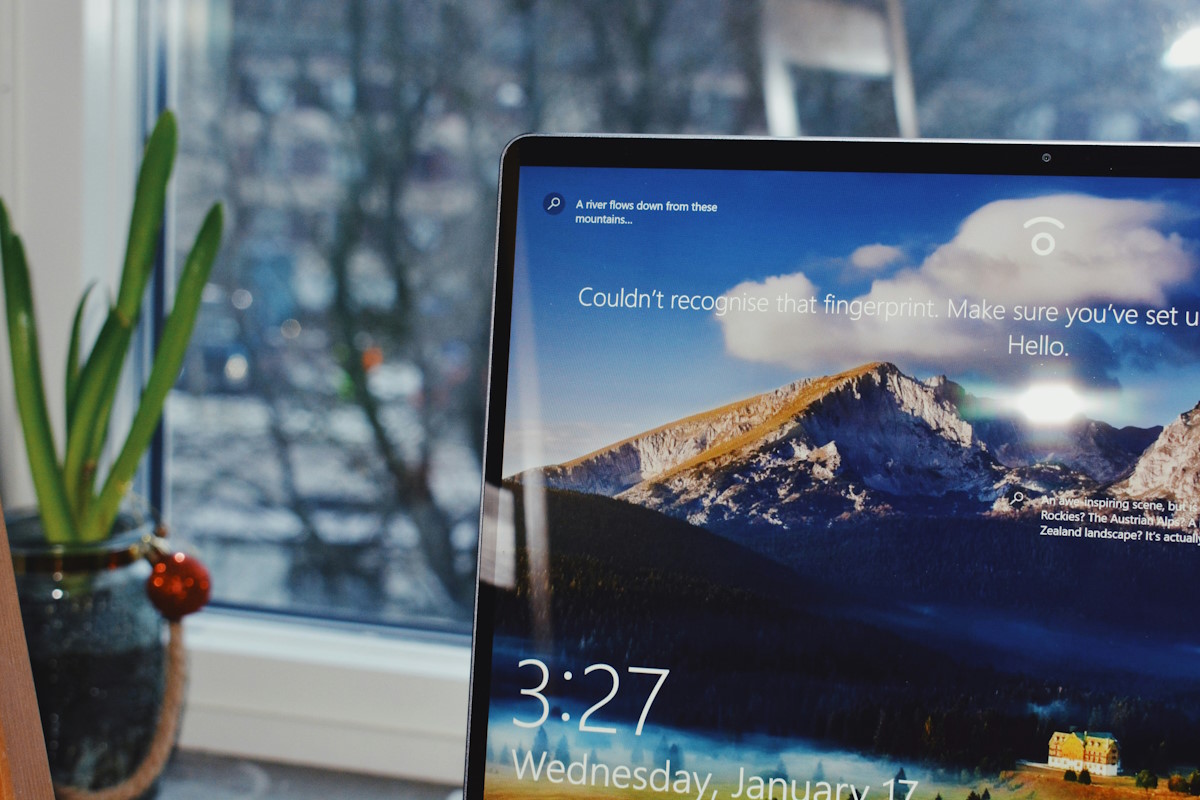












Is it compatible with Windows 10 version 1909 ?
So what does Basic really mean
A value of 1 (Basic) sends the same data as a value of 0, plus a very limited amount of diagnostic data such as basic device info, quality-related data, and app compatibility info. Note that setting values of 0 or 1 will degrade certain experiences on the device.
What experiences will be degraded? Microsoft publishes nothing on this.
Win 7 & 8 also have telemetry however not as invasive or marketing focused as Win 10.
Microsoft ALWAYS had telemetry baked into the OS.
Read this regarding Vista telemetry:
http://news.softpedia.com/news/Forget-about-the-WGA-20-Windows-Vista-Features-and-Services-Harvest-User-Data-for-Microsoft-58752.shtml
It sounds to me like MS is collecting far more than it needs for “diagnostic data.” I can’t imagine the bandwidth that is being wasted on MS’s desire for “diagnostic data.”
This “will degrade certain experiences” threat really needs to be quantified. What exactly is degraded, and why won’t they explain it?
Now, you can also configure Cortana to read your Outlook emails aloud = your emails are being Telemetry’ed to M$.
Maybe, Jennifer Lawrence can also tell Cortana to show her her nude photos.
AnoKnee Merce:
“Maybe, Jennifer Lawrence can also tell Cortana to show her her nude photos.”
Wait — Cortana can *do* that? Maybe I wrote off Windows 10 a little too quickly… ;-)
Even better use Linux.
@John Fenderson:
“The only acceptable telemetry is opt-in telemetry.”
I also agree. If Linux Mint sticks with Ubuntu as a base (and I’m pretty sure they’re going to for at least the next major release), I have a strong hunch they will strip out Ubuntu’s telemetry stuff, or at a minimum switch it from opt-out to opt-in.
If it were only that easy, there’s a reason Linux only has 3% of the market & you better be a programmer, dev or engineer to use it. Plus almost everything breaks on that thing eventually.
Ubuntu is and has been gathering info from users. And one distro “Namib” looks to have plans for coin mining built into the OS. (They already have it in their forums) Linux is bad news, get a Mac instead.
@ddk: “you better be a programmer, dev or engineer to use it. Plus almost everything breaks on that thing eventually.”
Neither of those things are actually true.
“Ubuntu is and has been gathering info from users.”
Only if you allow it to. Also, Ubuntu is far from the only distro out there (personally, Ubuntu gives me nothing but headaches, so I avoid it.)
Ubuntu telemetry will be open source unlike Windows 10, people will be auditing the source code so we know what data will be sent where as on Windows 10 we have no clue what data is being sent nor can we audit the source code.
@dark: “Ubuntu telemetry will be open source”
That doesn’t make it acceptable, though. The only acceptable telemetry is opt-in telemetry. That said, even opt-out telemetry is miles better than what Microsoft foists on us.
@John Fenderson:
“The only acceptable telemetry is opt-in telemetry.”
Thirded. I mean, me three. I mean, I also agree. If Linux Mint sticks with Ubuntu as a base (and I’m pretty sure they’re going to for at least the next major release), I have a strong hunch they will strip out Ubuntu’s telemetry stuff, or at a minimum switch it from opt-out to opt-in.
@ John Fenderson Agreed.
@ddk Linux desktop only has 3% market share cuz Linux lacks software’s and games only available on Windows. And a lot of people are not aware there are plenty of good alternative software’s exist on Linux. Most of the windows software’s and games can be run on Linux with Wine, PlayOnLinux or Lutris or with VirtualBox or QEMU with GPU passthrough anyway.
Sorry for repeating myself and being a bore, but I used PCLinuxOS full-time for a year around ten years ago, and I didn’t learn a damn thing about Linux because *nothing ever broke* — *ever*. I *never* had to search the Web for help; I *never* had to use the command line. I’ve been running Linux Mint in a virtual machine for over a year, and the only real problems I’ve run into have been *VirtualBox-compatibility* problems, not *Linux* problems. (And even though I’m not remotely a programmer, developer, or engineer, I’ve been able to fix *all* of them.) Plus, I’ve run into many posts from professional sysadmins who got fed up with constantly having to fix problems on their aging relatives’ Windows computers, installed Linux on their machines (usually Linux Mint or Ubuntu), and then “never heard from them again” because there were no more problems to fix.
Clearly, OSX is a lot more carefully tested, better debugged, and more stable than Windows is, in part because it’s designed to run run only on a limited number of very expensive proprietary machines. My brother is a professional software architect, and he’s transitioned to Mac. But that’s because his company’s laptop fleet now consists mostly of Macbook Pros. To do *actual production work*, however, they run CentOS in virtual machines on their Macbooks…
Just use Simplewall and Enable Filtering in whitelist mode. It will block all telemetry. Windows 10 will be forced to ask your permission to access the internet. Only the apps you allow can access the internet.
github.com/henrypp/simplewall
Yes… Thanks!
Thanks for this info…
Don’t use windows 10
Here is my list of things which seem to somewhat tame LTSB2016/Server2016 and Enterprise1709:
[https://i.imgur.com/ZlIzQ6f.png]
Ofcourse, this isn’t enough, you’ll have to also disable everything under Privacy in the universal application Settings, and everything telemetry related under taskschd.msc and services.msc
And it still won’t be enough since the “Security” level 0 reads as: “A value of 0 will send minimal data to Microsoft. This data includes Malicious Software Removal Tool (MSRT) & Windows Defender data, if enabled, and telemetry client settings.”
Pay attention to the used wording: “This data includes”. It “includes”, which is not the same with “limited to”. So it still does nasty stuff in the background, you will still see unreasonable amounts of disk activity on idle, and you will still see unreasonable amounts of connections which were not initiated by the user.
Best wishes if you’re on Home or Home”Pro” editions.
Pay attention to the used wording: “This data includesâ€. It “includesâ€, which is not the same with “limited toâ€.
That’s how Win10’s EULA sounds to me. I avoid businesses that use legal documents like that.
Thanks a lot for this excellent sum-up !